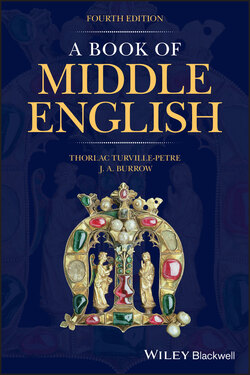Читать книгу A Book of Middle English - J. A. Burrow - Страница 43
4.4.2 Inflexions for Case
ОглавлениеThough this distinction between definite and indefinite adjectival inflexions survived for a considerable time, the Old English adjectival case system was dismantled much more rapidly. In Old English the adjective agreed with its noun in case, gender and number. Only in Southern and South‐Western texts do the case‐inflexions survive to a limited extent.
In Laʒamon’s Brut (text 3) there are, in addition to the ending ‐e (or ‐en) for adjectives of the definite declension, the following inflexions for indefinite adjectives:
| singular | ||
| masc. | nom. | no ending: god (137) |
| acc. | ‐ne: nenne (28), stærcne (59), bradne (115) | |
| gen. | ‐es | |
| dat. | ‐en: aðelen (11) | |
| fem. | dat. | ‐ere: ludere (30), hæhʒere (126) |
| plural | gen. | ‐(e)re: alre (33), wihtere (125) |
In The Owl and the Nightingale (text 2), adjectives add ‐e for all cases in the definite declension, and all in the indefinite declension except the nominative singular of all genders and the accusative singular masculine and neuter. So when qualifying a noun that is subject the adjective has no ending, as the three here: þat plait was stif and starc and strong (l. 5); with a feminine noun that is object, the adjective has ‐e as in grete tale, ‘a great debate’ (l. 3).
